Chance Vout XF5U-1 Skimmer

This curious aircraft, designed by the Chance-Vout company of United Aircraft, was first shown to the public in June 1946. Everyone who saw him at least once, without saying a word, gave him funny nicknames: "flying frying pan", "skimmer" ("skimmer"), "pancake", "half-baked pie", "flying saucer" and so on. But despite its truly odd appearance, the Chance Vout XF5U-1 was a formidable machine. History its that.
In 1933, a prominent American aerodynamic scientist Charles Zimmerman conducted a series of experiments with a low aspect ratio wing. Theoretical studies have shown the effectiveness of this scheme. At the ends of the ultra-low aspect ratio wing, it was supposed to put propellers rotating in the direction opposite to the direction of rotation of the vortices descending from the wing. Then the inductive resistance of the "wing-propellers" system would fall, and the aerodynamic quality would increase from 1 to 4, that is, it would be possible to build an aircraft with a huge range of speeds. Low-speed, large-diameter propellers with sufficient power-to-weight will allow you to hang like a transverse helicopter and make a vertical takeoff, while low drag will give an aircraft speed. In 1935, Zimmermann built a manned model with a span of 2 m and equipped it with 2 × 25 hp. air-cooled Kleon engines. The pilot had to lie inside the fuselage - the wing. But the model did not get off the ground due to the impossibility of synchronizing the rotation of the screws. Then Zimmermann built a rubber-motor model of a half-meter span. She flew successfully. After support at NASA, which had previously rejected Zimmermann's inventions as too modern, the designer was invited in the summer of 1937 to work for the Chance Vote company (CEO Eugene Wilson). Here, using the great potential of the laboratories, Charles built a model - a V-162-meter-wide electrolyte. He made a number of successful flights in the hangar.
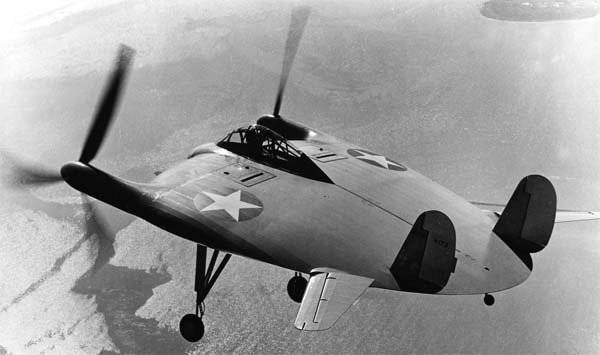
At the end of April 1938, Zimmermann patented his plane, designed for two passengers and a pilot. The military department became interested in his developments. At the beginning of 1939, as part of a competition for a fighter of an unconventional scheme, in which, in addition to Chance-Vouth, the firms Curtiss and Northrop took part, Charles began to develop and build a light-engine analogue of the V-173. The work was funded by the US Navy. The V-173 had an intricate wood structure covered in fabric. Two synchronized 80 hp Continental A-80 engines rotated through gearboxes huge three-blade propellers with a diameter of 5,03 meters. Wingspan 7,11 m, its area 39,67 m2, the length of the machine is 8,13 m. For simplicity, the chassis was made non-retractable, with rubber shock absorption. The wing profile was chosen symmetric, NASA - 0015. The plane was controlled by means of two keels with rudders, and in roll and pitch - with the help of all-rotary elevons. Due to the revolutionary nature of the V-173 concept, it was decided to blow it in one of the largest wind tunnels in the world, at the Langley Field test facility, before the start of flight tests. Everything was successfully completed in December 1941. Flight tests began.
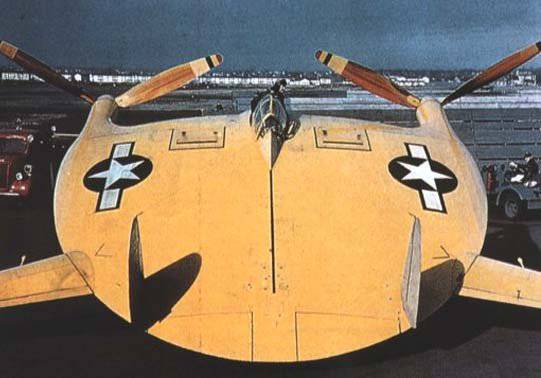
After short runs and sorties at the firm's airfield in Stratford, Connecticut, Boone Guyton's chief pilot flew the V-23 on November 1942, 173. The first 13-minute flight showed that the load on the handle, especially in the roll channel, was excessively high. This drawback was eliminated by installing weight compensators, selecting the pitch of the screws depending on the operating mode of the engines. The plane became obedient in control. Guyton stated that the stick deflects 45 degrees in both directions in the pitch channel without excessive effort. Despite the secrecy of the program, V-173 flew a lot outside of Stratford airfield, becoming "his" in the skies of Connecticut. With a flight weight of 1400 kg, the power is 160 hp. the car was clearly not enough. Several times, as a result of engine failure, the V-173 made forced landings. Once on a sandy beach I skipped (small diameter wheels were buried in the ground). But every time a very low landing speed and structural strength saved it from serious damage.
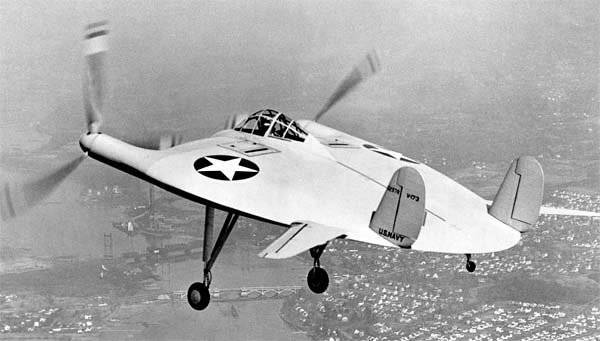
The main disadvantage of the V-173 Guyton and the famous pilots Richard "Rick" Burove and Charles Lindbergh, who joined him in the testing process, recognized the poor visibility from the cockpit forward during taxiing and during takeoff. The reason for this is a very large parking angle, 2215. Then they raised the pilot's seat, made a porthole for downward and forward viewing. But this did not help much either. The takeoff run of the aircraft was only 60 meters. With a headwind of 46 km / h, it rose vertically into the air. The ceiling of the car is 1524 m, the maximum speed is 222 km / h. In parallel with the design and testing of the V-173, Chance Vout began designing a fighter. The contract for its development was received from the Navy on September 16, 1941, a day after giving consent to purge the V-173 in the Langley Field pipe. This project had the brand name VS-315. After the successful completion of the V-173 purges (January 19, 1942), the US Navy's Bureau of Aeronautics requested a technical proposal from the firm for the construction of two prototypes and a 1/3 life-size purge model.
By May 1942, work on the technical proposal was completed. The young talented engineer Eugene "Pike" Greenwood joined Zimmerman's team. He was responsible for designing the new aircraft structure. In June, the technical proposal was submitted to the Bureau of Aeronautics, and the future aircraft was named according to the system adopted by the Navy: XF5U-1. Its main feature was the ratio between maximum and landing speed - about 11, according to the usual scheme - 5. The design speed range is from 32 to 740 km / h. To achieve these characteristics, many problems had to be solved. For example, at low flight speeds, the angle of attack increased greatly. Due to the asymmetry of the flow, very strong vibrations were noted on the V-173, which threatened the strength of the structure. To get rid of this regime, the Chance-Vout firm, in collaboration with the Hamilton Standard firm (which made propellers), developed a propulsion system called the "balanced propeller." Wooden blades of a very complex shape, with a wide butt, were attached to steel lugs connected to the swashplate. With its help, it was possible to change the cyclic pitch of the blades.
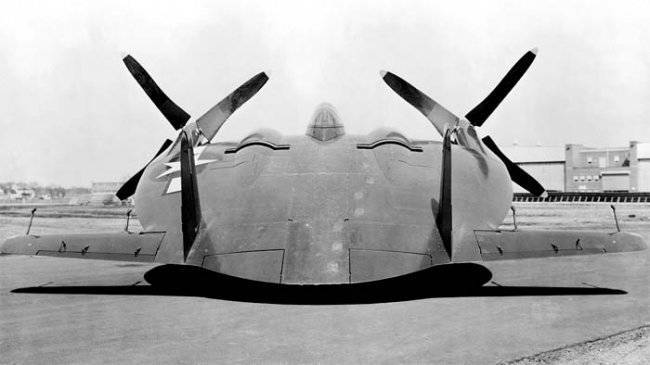
The Pratt-Whitney company also took part in the creation of the propeller motor group. She designed and manufactured a synchronizer for R-2000-7 engines, five-time gearboxes, clutches that allowed either of the two motors to shut down in case of damage or overheating. The specialists also helped design a fundamentally new fuel system that allowed the engines to be powered during a long flight at high angles — attacks (up to 90╟ while hovering in a helicopter mode). Externally, the XF5U-1 almost repeated the V-173. The same remained and control system. The pilot's gondola and the wing - the fuselage of a semi-monocoque structure were made of metalite (a two-layer panel of balsa and aluminum sheet) of a very durable and fairly lightweight. Engines, recessed in the wing - the fuselage, had good access. It was planned to install 6 machine guns "Colt-Browning" caliber 12,7 mm with a supply of cartridges for 200 pcs. on the barrel, four of which on production machines wanted to replace the Ford-Pontiac M-20А with 39-mm guns, which were still under development by that time. The wooden layout of the XF5U-1 fell on the mockup commission of the 7 Navy June 1943. He had three-bladed screws. After the alterations caused by the commission’s remarks, the contract for the production of prototypes again submitted for consideration for inexplicable reasons was signed only on July 15 of the year 1944. It was decided to equip the first prototype with Pratt-Whitney R-2000-7 engines (1100 hp - maximum power, 1350 hp - at the injection pump with water injection), the second - XR-2000-2, with Wright turbine generators. Armament on the first prototype was not installed. The first prototype of the XF5U-1 was rolled out of the 25 June 1945 hangar. By this time, the firm received permission to conduct flight tests at the well-equipped Murok Dry Lake (California) test site. Previously, 24 March, she appealed to the Navy with a request to continue funding the project, since the loan allocated to XF5U-1, was already squandered. To save money, the flight test program was cut, in particular, its flight part and static tests.
Temporarily equipped with 4-blade propellers similar to those used on the F4U-4 Corsair fighter (Hamilton model Hydromatic), the XF5U-1 successfully steered. The second instance was used for static tests. After installing “unloaded propellers” on the first prototype, Bun Gaitan finally lifted the plane into the air in mid-January 1947. Skimmer, as they called the car at the company, passed the flight test program with flying colors, reaching a record speed of 811 km / h for that time. This unofficial record belonged to Richard Burovs. He reached speeds at an altitude of 8808 m in afterburner mode. The possibilities of vertical take-off from a special trapeze “in helicopter”, with screws up, and hovering also in “helicopter” were demonstrated. The Skimmer was prepared for shipping by sea through the Panama Canal to California, but the program was suddenly closed. There were two main reasons: financial difficulties at the company, and the rejection of Skimmer was the easiest way to save money, and the fact that rearmament was already underway fleet US jet technology. In the spring of 1948, according to the instructions of the Navy, all valuable equipment was removed from the aircraft, and the hulls were turned into scrap metal by bulldozers. At about the same time, V-173 was transferred to the museum at the Smithsonian Institution, where it is stored to this day.
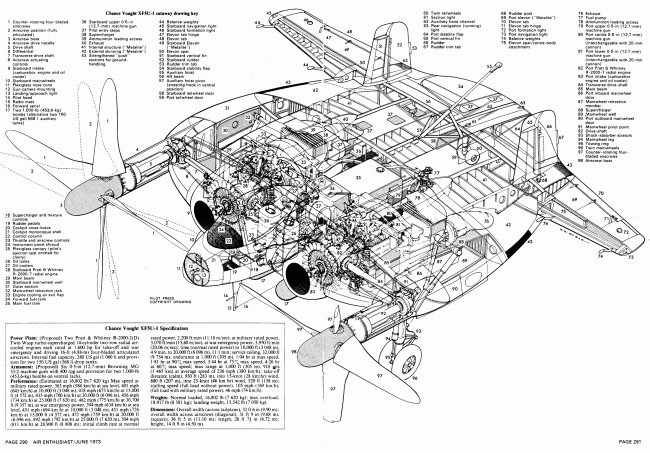
Aircraft design
The XF5U-1 fighter was a two-powered integral-configuration monoplane with an elliptical wing of the NACA 0015 symmetric profile throughout its span.
Structurally, the aircraft consisted of three main parts: the front, middle and rear. In the front there was a pilot's cabin, air intakes with fans of forced cooling of engines and compartments with small arms. The middle part of the fuselage was formed by two power frames-spars, between which were located the engines, the main and consumable tanks, shafts and gear drives of the screws. In its lower part, the main landing gear was fastened to the front power frame. In the rear were the main controls of the aircraft, the tail wheel and the brake hook.
The power set of the structure was made of aluminum alloys, and the lining of the new composite material was metalite, patented by Vought and representing a sandwich glued and formed in a large autoclave from two thin aluminum sheets separated by a layer of ultra-light wood - balsa. The strength and rigidity of the material obtained made it possible to radically reduce the number of frames and ribs reinforcing the aircraft's casing, making the structure almost monocoque.
Cockpit airtight, closed drop-shaped sliding light. The drive of the moving part of the lantern is electric. Pilot's seat - ejection, such as JD-1, produced by the British company Martin-Baker. On the front panel of the instrument panel were the main flight-navigation instruments, instruments for monitoring the systems of the aircraft and the power plant. On the left panel were located knobs engine controls, the cyclic pitch of the screws, trim tabs, chassis and brake hook. The right panel was occupied by a gas station and a radio station control panel.
The power plant consisted of two 14-cylinder twin-row Pratt & Whitney R-2000-2 (D) Twin Wasp engines with a capacity of 1600 hp each. On the front of the crankcase of each engine, a gearbox with bevel gears was fixed, which transmitted torque to a single transverse shaft of the propeller drive. In addition, an engine cooling fan was connected to the gearbox. Exhaust hot air exited through adjustable flaps on the lower and upper surfaces of the fuselage. Exhaust gases were discharged through a manifold and a U-shaped exhaust pipe under the fuselage. In the event of a failure of one of the engines, the pilot could disconnect it from the gearbox using the appropriate clutch. Aircraft propellers - with variable general and cyclic pitch. The propeller blades are wooden.
Aircraft landing gear tricycle with tail wheel. All racks are two-wheeled. Hydraulic cleaning system. The large parking angle of the aircraft forced the designers to fix the brake hook on the upper surface of the fuselage. The mechanism of release and cleaning of the hook is hydraulic, pyramidal type.
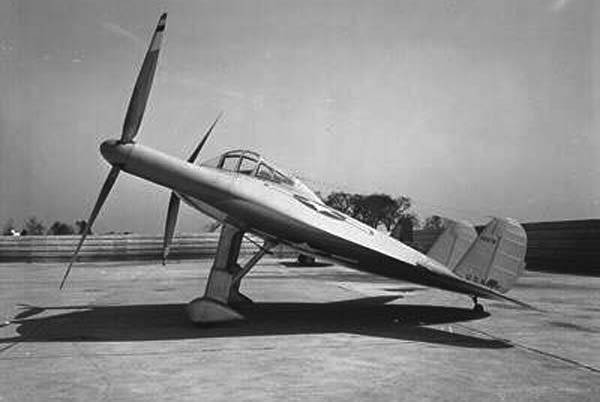
The control system of the aircraft is mechanical, rigid. By roll and pitch, the machine was controlled using differential deflectable all-round stabilizers. Stabilizers are equipped with trimmers and external weight compensators. Stabilization of the aircraft in the direction is provided by two trapezoidal keels with rudders of a large area. In the tail of the aircraft were installed automatic flaps, used when landing for parrying.
The fighter’s radio equipment consisted of a short-wave radio station and a radio compass. The antennas of these devices were under the fuselage. On prototypes XF5U-1 weaponry was not installed. Serial machines were supposed to arm six Browning 12,7-mm machine guns with 400 ammunition for ammunition or four X-NUMX-mm M-20 cannons. Under the fuselage two pylons could be installed for hanging bombs with a total weight of up to 39 kg or fuel tanks with a capacity of 454 l. The use of unguided rockets or dive-bombing was completely ruled out due to the large diameter of the propellers.
Information